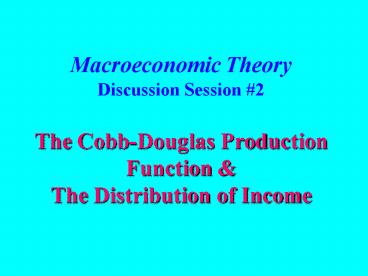Macroeconomic Theory Discussion Session PowerPoint PPT Presentation
1 / 24
Title: Macroeconomic Theory Discussion Session
1
Macroeconomic TheoryDiscussion Session 2The
Cobb-Douglas Production Function The
Distribution of Income
2
Micro Theory of Firm Behavior
- Assume perfect competition
- Firms take factor prices as given
- Representative firm sells output (Y)
- At a price (P)
- And pays labor (L) a wage (W)
- And rents capital (K) at a rate (R)
3
Firm Maximizes Profit
- Profit Total Revenue - Total Cost
- P ? Y - W ? L R ? K
- or
- Profit P ? f(K, L) - W ? L R ? K
- and the firm selects the level of K and L that
maximizes profit
4
How does the firm pick K L?
- Economic intuition
- Suppose the firm with units of capital hires
an additional worker. - The extra output realized by hiring that worker
is called the marginal product of labor
5
Output
f(K, L)
f(K, L11)
f(K, L1)
Labor
L1
L11
6
- Firm compares the cost of hiring that worker, W,
with the extra revenue it receives, P ? MPL - If P ? MPL gt W then the firm hires the worker.
- If P ? MPL lt W then the firm will not hire.
- Equilibrium occurs when P ? MPL W or
- Similarly, the firm will add additional units of
capital until
7
Distribution of National Income
- Assuming that firms in the aggregate behave in
this fashion then each factor of production earns
its marginal contribution to production. - Labor earns
- Capital earns
8
Real Economic Profit
- In the Classical Model, total output is equal to
- Real Economic Profit
9
Eulers Theorem
- If the production function exhibits constant
returns to scale then Real Economic Profit must
equal zero.
10
Eulers Theorem
- Total output is divided between payments to
capital and labor. - Who gets what depends on the marginal products of
capital and labor.
11
Example
- Consider the production function
- Suppose K 40 and L 10
- Q What is Y?
- Q Does f(K, L) exhibit constant returns to scale?
Y20
Yes
12
Does Eulers Theorem Hold?
13
Cobb-Douglas Production Function
- Paul Douglas, an economics professor and US
Senator from Illinois observed that the division
of national income between capital and labor had
been roughly constant over a long period of time. - Douglas asked his colleague, Charles Cobb a
mathematician for help.
14
Requirements
- Stylized facts
- Capital Income MPK ? K aY
- Labor Income MPL ? L (1-a)Y
- 0 lt a lt 1
- a measures Capitals share of total income
15
Charles Cobbs Solution
- where A gt 0 and measures the productivity of the
available technology. - A C A M
fter
onsiderable
lgebraic
anipulation
16
- For the Cobb-Douglas production function the
marginal productivity of a f.o.p. is proportional
to its average productivity. - Eulers Theorem
- The ratio of labor income to capital income is
constant and equal to - Factor shares do not depend on K, L, or A.
17
Application
- Consider a Cobb-Douglas production function with
3 factors of production - Where H is human capital measured by the number
of college degrees among the workers.
18
- a. Find the marginal product of labor.
- Q How does an increase in human capital affect
the marginal product of labor?
A An increase in human capital increases the
marginal product of labor, i.e., more human
capital makes the existing labor more productive.
19
- b. Find the marginal product of human capital.
- Q How does an increase in human capital affect
the marginal product of human capital?
A An increase in human capital decreases the
marginal product of human capital, i.e., there
are diminishing returns to acquiring additional
degrees.
20
- c. What is the income share paid to labor?
A Labors share is the proportion of total
output that is received by workers. The total
amount of output that goes to workers is the real
wage times the quantity of labor. Assuming
perfect competition, this equals MPL ? L.
Labors share of output is then MPL ? L divided
by total output
21
Q What is the income share paid to
capital? Q In the national accounts, what
share of total income do workers appear to
receive?
A Labor gets one-third, human capital gets
one-third. Since workers own their human capital
it appears that labor gets 2/3 of total output.
22
- d. If unskilled workers earn the MPL and skilled
workers earn MPLMPH, find the ratio of the
skilled wage to the unskilled wage.
23
- Q How does an increase in human capital affect
this ratio?
A Note that the ratio is always greater than 1,
i.e., skilled workers earn more than unskilled
workers. When H increases this ratio falls
because the diminishing returns to human capital
lower its return while at the same time
increasing the marginal product of unskilled
workers.
24
Policy Analysis
- Q Does government funding of college
scholarships lead to a more egalitarian society?
A If more college scholarships increase H, then
the answer is yes. The policy lowers the returns
to education, decreasing the gap between the
wages of more and less educated workers. More
importantly, the policy raises the absolute wage
of unskilled workers because their marginal
product rises when the number of skilled workers
rises.

